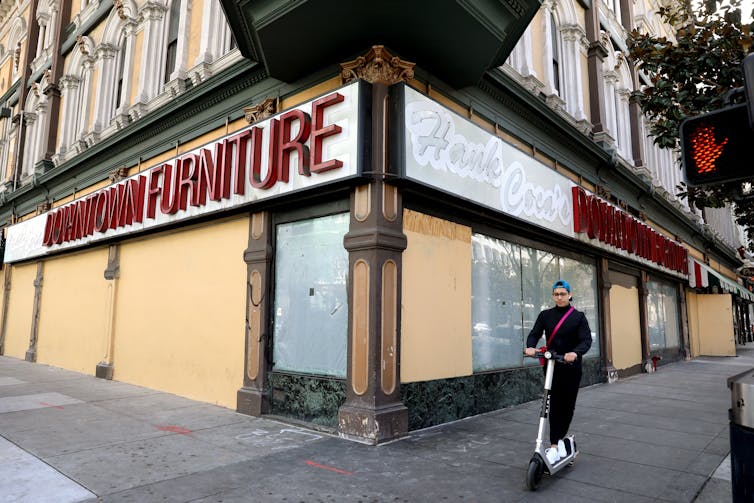The specter of downtown decline is again haunting American cities.
After many decades of reinvestment and repopulation, some American downtowns are now showing signs of hollowing out again.
The COVID-19 pandemic certainly bears some of the blame.
The widespread adoption of remote and hybrid work schedules has drained commercial offices and caused tenants to terminate leases. In many downtowns, office occupancy is at 50% pre-pandemic levels. Ripple effects include shrinking lunchtime crowds, slumping retail sales and a drop-off of public transit ridership. For example, New York City’s subway is at 65% of pre-pandemic ridership as of early 2023.
I study how urban governance challenges shape city budgets, so I’m aware of how these pandemic-related changes are making long-term urban problems worse at a time many cities are dealing with strained budgets.
Pre- and post-pandemic urbanism
Tightening city government finances and growing service demands are threatening to produce Donut City 2.0. A donut city is defined by out-migration, with the city center losing residents and businesses to the suburbs.
This is not a rerun of hollowing out experienced in many U.S. cities in the 1960s. The usual culprits of economic restructuring, racial tensions, shifting consumer preferences and government inefficiency are all still involved, but these forces are now manifest in new ways.
After the financial crisis that began the Great Recession in 2007, cities got spooked. When housing markets collapsed and stock markets sank, cities found themselves running out of money. Many of them, like Chicago and Memphis, siphoned revenues into reserves and made recessionary budget cuts permanent. Some cities, like Dallas and Portland, have also had to face up to their huge unfunded pension liabilities. Servicing debts and shoring up finances has often been prioritized over providing services and building infrastructure.
This post-Great Recession restructuring has now run headlong into the post-pandemic economy.
Exactly what this collision looks like varies from one municipality to the next, but some broad trends are emerging. Front and center is a growing demand for city services. Since 2020, this demand has been slaked by the federal government’s pandemic relief money, but now these funds are running out.

A growing demand
What kind of services are needed? Here are a few examples.
According to the U.S. Department of Housing and Urban Development, nationwide homelessness numbers have been trending upward since 2016. In 2022, a post-pandemic spike left this number just shy of 600,000 people, up 50,000 in six years.
The demand for law enforcement is also growing. World Bank data shows that U.S. crime rates began trending upward in 2014. This trend again accelerated during the pandemic. New York City’s 2021-22 spike in crime made headlines globally. Although crime rates have now abated in most U.S. cities, local governments are dealing with a public perception that their cities are less safe. Hiring remains challenging.
Donut amid shimmering silicon

San Jose, California, a city of 1 million, does not conjure archetypal images of urban decline. It is not home to redundant smokestacks and empty houses. It is a city that is home to thousands of global technology firms and suffers from vastly inflated housing costs. And yet, despite its wealth, it is struggling with the pressures of Donut City 2.0.
As may seem fitting for the home of Zoom’s headquarters, San Jose has seen some of the lowest rates of return to office working. The city’s return rate is just 44% vs. national averages that are at about 50%. PayPal, Roku, Western Digital and X – formerly known as Twitter – have also laid off what amounts to thousands of San Jose-based employees, putting further pressure on commercial occupancy rates.
This does not make San Jose unique. What it does do is put more pressure on city revenues.
Drop-off in investment
When cities see declines in commercial occupancy, they get hit in multiple ways.
One way is that it makes future investment less likely. San Jose’s economic growth hinges on Google’s planned expansion and an in-progress connection to the regional BART transit system. Given all that empty office space and large drop-offs in BART ridership, these plans now face a more uncertain future.

San Jose has a US$1.2B general fund annual budget. Business taxes represent a relatively small slice – 6%, or $70 million – of its total revenues. For comparison, property taxes are 32% and sales taxes are 23%. This means San Jose is less sensitive to commercial decline than other cities. And yet, small budget changes can have large consequences.
San Jose entered the pandemic with significant, if not unique, challenges. In 2011, San Jose acknowledged that it owed retirees $3 billion more than it held in assets. An acrimonious fight between the city and labor unions followed. The eventual settlement set San Jose on a path to make good on its pension promises, but correcting for years of skipped and inadequate payments will squeeze the city’s budget for decades to come.
This squeezing has already been felt. San Jose cut its payroll during the Great Recession and these cutbacks have not been restored. The city currently has nearly 860 vacant staff positions, unfilled because of a lack of funding.
This understaffing exacerbates other problems. Like other California cities, such as San Francisco, San Jose is experiencing a major homelessness crisis. In 2023, the city spent $116 million trying to alleviate the problem by providing counseling services and investing in affordable housing. Yet San Jose’s unhoused population grew to 6,340 by the spring of 2023 – up from an estimated 4,350 in 2017.
Debate over the city’s 2023-24 budget revolved around how best to solve growing homelessness. The new mayor, Matt Mahan, succeeded in diverting some long-term affordable housing dollars to more immediate housing needs, but the overwhelming consensus was that this influx of cash would not be enough to solve San Jose’s homelessness problem.
New funds will be hard to find. Raising either property or sales taxes without incurring negative consequences, like further declines in local consumer spending and sales tax revenue, is unlikely.
In 2020, the city was successful in introduced a new property transfer tax to address housing problems, making an additional tax a hard sell. So, the city is left moving around expenditures within a largely constrained budget.
Multiple stressors
San Jose is not alone in facing this conundrum.
Cities across the country are experiencing inflexible expenditures and highly constrained revenues. Without residents’ demands being met, the prospects of hollowing out increase. Budget projections look bleak in many cities, with notable cases including large metros such as Chicago, Houston, San Francisco and New York City.
The outlook will largely depend on the reaction of residents and businesses. In 2022, the U.S. Census Bureau reported that San Jose had lost 42,000 residents, the city’s population declining 4.1% since 2020.
It’s not yet clear how important or uniform this trend will become. What we do know is that the federal and many state governments have their own budget issues and will therefore not be moving in with a fix.
Unlike 50 years ago, cities are now more entrepreneurial, aggressively competing against each other for residents, businesses and state and federal funds. Stemming decline will involve getting creative with limited financial resources. For those cities that lose out, the subsequent struggle for survival could mirror the worst of 20th century urban decline.

